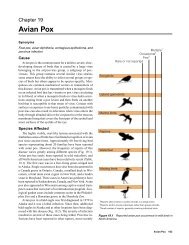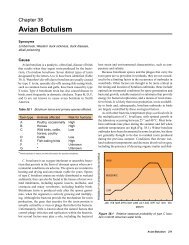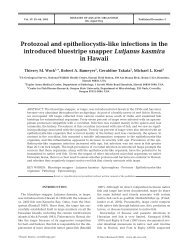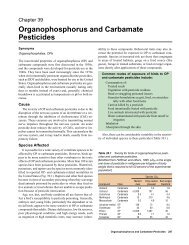Biowarfare, Bioterrorism, and Animal Diseases as Bioweapons
Biowarfare, Bioterrorism, and Animal Diseases as Bioweapons
Biowarfare, Bioterrorism, and Animal Diseases as Bioweapons
Create successful ePaper yourself
Turn your PDF publications into a flip-book with our unique Google optimized e-Paper software.
Inc., 181 p.<br />
28. Davis, C.J., 1999, Nuclear blindness: an overview of the<br />
biological weapons programs of the former Soviet Union<br />
<strong>and</strong> Iraq: Emerging Infectious <strong>Dise<strong>as</strong>es</strong>, v. 5, p. 509–512.<br />
29. Henderson, D.A., 1999, The looming threat of bioterrorism:<br />
Science, v. 283, p. 1279–1282.<br />
30. Fenner, F., Henderson, D.A., Arita, I., Ježek, Z., <strong>and</strong> Ladnyi,<br />
I.D., 1988, The epidemiology of smallpox, in Fenner,<br />
F., Henderson, D.A., Arita, I., Ježek, Z., <strong>and</strong> Ladnyi, I.D.,<br />
Smallpox <strong>and</strong> its eradication: Geneva, Switzerl<strong>and</strong>, World<br />
Health Organization, p. 169–208. (http://www.who.int/emc/<br />
dise<strong>as</strong>es/smallpox/Smallpoxeradication.html)<br />
31. Christopher, G.W., Cieslak, T.J., Pavlin, J.A., <strong>and</strong> Eitzen,<br />
E.M., Jr., 1999, Biological warfare: a historical perspective,<br />
in Lederberg, J., ed., Biological weapons: limiting the<br />
threat: Cambridge, M<strong>as</strong>s., MIT Press, p. 17–35.<br />
32. Henderson, D.A., 1998, <strong>Bioterrorism</strong> <strong>as</strong> a public health<br />
threat: Emerging Infectious <strong>Dise<strong>as</strong>es</strong>, v. 4, p. 488–492.<br />
33. Harris, S., 1999, The Japanese biological warfare programme:<br />
an overview, in Geissler, E., <strong>and</strong> van Courtl<strong>and</strong><br />
Moon, J.E., eds., Biological <strong>and</strong> toxin weapons: research,<br />
development <strong>and</strong> use from the Middle Ages to 1945: Oxford,<br />
UK, Oxford University Press, p. 127–152.<br />
34. Wheelis, M., 1999, Biological sabotage in World War I, in<br />
Geissler, E, <strong>and</strong> van Courtl<strong>and</strong> Moon, J.E., eds., Biological<br />
<strong>and</strong> toxin weapons: research, development <strong>and</strong> use from<br />
the Middle Ages to 1945: Oxford, UK, Oxford University<br />
Press, p. 35–62.<br />
35. Postgate, J., 1992, Microbes <strong>and</strong> man (3rd ed.): Cambridge,<br />
UK, Cambridge University Press, 297 p.<br />
36. Centers for Dise<strong>as</strong>e Control <strong>and</strong> Prevention, 2000, Biological<br />
<strong>and</strong> chemical terrorism: strategic plan for preparedness<br />
<strong>and</strong> response: recommendations of the CDC strategic planning<br />
workgroup: Morbidity <strong>and</strong> Mortality Weekly Report,<br />
v. 49, p. 1–14.<br />
37. Lederberg, J., ed., 1999, Biological weapons: limiting the<br />
threat: Cambridge, M<strong>as</strong>s., MIT Press, 351 p.<br />
38. Osterholm, M.T., <strong>and</strong> Schwartz, J., 2000, Living terrors:<br />
what America needs to know to survive the coming bioterrorist<br />
cat<strong>as</strong>trophe: New York, N.Y., Delacorte Press, 232 p.<br />
39. Rotz, L.D., Koo, D., O’Carroll, P.W., Kellogg, R.B., Sage,<br />
M.J., <strong>and</strong> Lillibridge, S.R., 2000, <strong>Bioterrorism</strong> preparedness:<br />
planning for the future: Journal of Public Health<br />
Management <strong>and</strong> Practice, v. 6, p. 45–49.<br />
40. Tucker, J.B., 1999, Historical trends related to bioterrorism:<br />
an empirical analysis: Emerging Infectious <strong>Dise<strong>as</strong>es</strong>, v. 5,<br />
p. 498–504.<br />
41. Dudley, J.P., <strong>and</strong> Woodford, M.H., 2002, <strong>Bioweapons</strong>,<br />
bioterrorism <strong>and</strong> biodiversity: potential impacts of biological<br />
weapons attacks on agricultural <strong>and</strong> biological diversity:<br />
Revue Scientifique et Technique, Office International des<br />
Epizooties, v. 21, p. 125–137.<br />
42. Bayer, R., <strong>and</strong> Colgrove, J., 2002, Public health vs. civil<br />
liberties: Science, v. 297, p. 1811.<br />
43. Centers for Dise<strong>as</strong>e Control <strong>and</strong> Prevention, 1999, <strong>Bioterrorism</strong><br />
alleging use of anthrax <strong>and</strong> interim guidelines for<br />
management–United States, 1998: Morbidity <strong>and</strong> Mortality<br />
Weekly Report, v. 48, p. 69–74.<br />
44. Enserink, M., 2003, Johns Hopkins biodefense pioneers<br />
depart en m<strong>as</strong>se: Science, v. 301, p. 1824.<br />
266 Dise<strong>as</strong>e Emergence <strong>and</strong> Resurgence: The Wildlife–Human Connection<br />
45. Hamburg, M.A., 2002, <strong>Bioterrorism</strong>: responding to an<br />
emerging threat: Trends in Biotechnology, v. 20,<br />
p. 296–298.<br />
46. Marshall, E., 2001, U.S. enlists researchers <strong>as</strong> fight widens<br />
against bioterrorism: Science, v. 294, p. 1254–1255.<br />
47. Budowle, B., Schutzer, S.E., Einseln, A., Kelley, L.C.,<br />
Walsh, A.C., Smith, J.A.L., Marrone, B.L., Robertson, J.,<br />
<strong>and</strong> Campos, J., 2003, Building microbial forensics <strong>as</strong> a<br />
response to bioterrorism: Science, v. 301, p. 1852–1853.<br />
48. Enserink, M., 2001, This time it w<strong>as</strong> real: knowledge of<br />
anthrax put to the test: Science, v. 294, p. 490–491.<br />
49. Henderson, D.A., Inglesby, T.V., <strong>and</strong> O’Toole, T., eds.,<br />
2002, <strong>Bioterrorism</strong>: guidelines for medical <strong>and</strong> public<br />
health management: Chicago, Ill., American Medical Association<br />
Press, 244 p.<br />
50. Chang, M.-H., Glynn, M.K., <strong>and</strong> Groseclose, S.L., 2003,<br />
Endemic, notifiable bioterrorism-related dise<strong>as</strong>es, United<br />
States, 1992–1999: Emerging Infectious <strong>Dise<strong>as</strong>es</strong>, v. 9,<br />
p. 556–564.<br />
51. Shalala, D.E., 2002, New directions for biomedical science:<br />
Science, v. 295, p. 585.<br />
52. Kadlec, R.P., Zelicoff, A.P., <strong>and</strong> Vrtis, A.M., 1997, Biological<br />
weapons control: prospects <strong>and</strong> implications for the<br />
future: Journal of the American Medical Association,<br />
v. 278, p. 351–356.<br />
53. Stone, R., 2001, Down to the wire on bioweapons talks:<br />
Science, v. 293, p. 414–416.<br />
54. Wheelis, M., 2001, Deterring bioweapons development:<br />
Science, v. 291, p. 2089.<br />
55. Carr, C., 2002, The lessons of terror: a history of warfare<br />
against civilians: why it h<strong>as</strong> always failed <strong>and</strong> why it will<br />
fail again: New York, N.Y., R<strong>and</strong>om House, 272 p.<br />
56. E<strong>as</strong>ley, C.E., <strong>and</strong> Allen, C.E., 2003, Exploring the roots to<br />
terrorism, in Levy, B.S. <strong>and</strong> Sidel, V.W., eds., Terrorism<br />
<strong>and</strong> public health: Oxford, UK, Oxford University Press,<br />
p. 335–350.<br />
57. Atran, S., 2003, Genesis of suicide terrorism: Science,<br />
v. 299, p. 1534–1539.<br />
58. Kaufmann, A.F., Meltzer, M.I., <strong>and</strong> Schmid, G.P., 1997,<br />
The economic impact of a bioterrorist attack: are prevention<br />
<strong>and</strong> postattack intervention programs justifiable?: Emerging<br />
Infectious <strong>Dise<strong>as</strong>es</strong>, v. 3, p. 83–94.<br />
59. Rotz, L.D., Khan, A.S., Lillibridge, S.R., Ostroff, S.M., <strong>and</strong><br />
Hughes, J.M., 2002, Public health <strong>as</strong>sessment of potential<br />
biological terrorism agents: Emerging Infectious <strong>Dise<strong>as</strong>es</strong>,<br />
v. 8, p. 225–230.<br />
60. Acha, P.N., <strong>and</strong> Szyfres, B., eds., 2001–2003, Zoonoses <strong>and</strong><br />
communicable dise<strong>as</strong>es common to man <strong>and</strong> animals (3rd<br />
ed.): W<strong>as</strong>hington, D.C., Pan American Health Organization,<br />
Pan American Sanitary Bureau, Regional Office of the<br />
World Health Organization, 3 v.<br />
61. Beran, G.W., <strong>and</strong> Steele, J.H., eds., 1994, H<strong>and</strong>book of<br />
zoonoses (2nd ed.): Boca Raton, Fla., CRC Press, 2 v.<br />
62. Krauss, H., Weber, A., Appel, M., Enders, B., Isenberg,<br />
H.D., Shiefer, H.G., Slenczka, W., von Graevenitz, A., <strong>and</strong><br />
Zahner, H., 2003, Zoonoses: infectious dise<strong>as</strong>es transmissible<br />
from animals to humans (3rd ed.): W<strong>as</strong>hington, D.C.,<br />
ASM Press, 456 p.<br />
63. Palmer, S.R., Soulsby, Lord, <strong>and</strong> Simpson, D.I.H., eds.,<br />
1998, Zoonoses: biology, clinical practice, <strong>and</strong> public

















